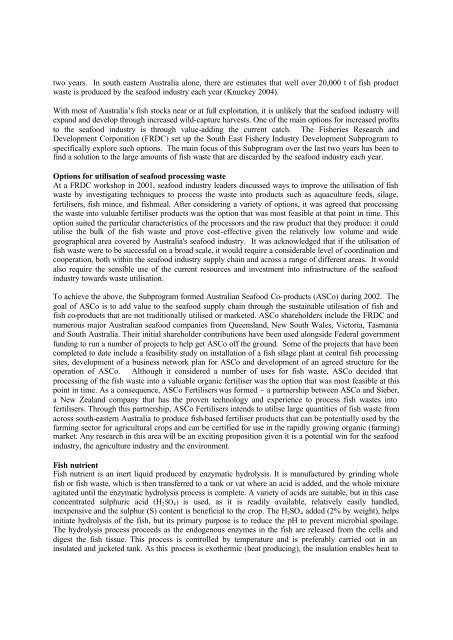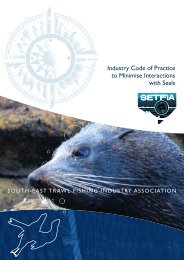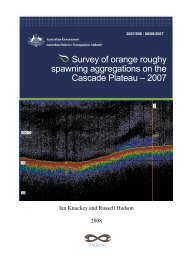Utilisation of seafood processing waste - Fishwell Consulting
Utilisation of seafood processing waste - Fishwell Consulting
Utilisation of seafood processing waste - Fishwell Consulting
You also want an ePaper? Increase the reach of your titles
YUMPU automatically turns print PDFs into web optimized ePapers that Google loves.
two years. In south eastern Australia alone, there are estimates that well over 20,000 t <strong>of</strong> fish product<br />
<strong>waste</strong> is produced by the <strong>seafood</strong> industry each year (Knuckey 2004).<br />
With most <strong>of</strong> Australia’s fish stocks near or at full exploitation, it is unlikely that the <strong>seafood</strong> industry will<br />
expand and develop through increased wild-capture harvests. One <strong>of</strong> the main options for increased pr<strong>of</strong>its<br />
to the <strong>seafood</strong> industry is through value-adding the current catch. The Fisheries Research and<br />
Development Corporation (FRDC) set up the South East Fishery Industry Development Subprogram to<br />
specifically explore such options. The main focus <strong>of</strong> this Subprogram over the last two years has been to<br />
find a solution to the large amounts <strong>of</strong> fish <strong>waste</strong> that are discarded by the <strong>seafood</strong> industry each year.<br />
Options for utilisation <strong>of</strong> <strong>seafood</strong> <strong>processing</strong> <strong>waste</strong><br />
At a FRDC workshop in 2001, <strong>seafood</strong> industry leaders discussed ways to improve the utilisation <strong>of</strong> fish<br />
<strong>waste</strong> by investigating techniques to process the <strong>waste</strong> into products such as aquaculture feeds, silage,<br />
fertilisers, fish mince, and fishmeal. After considering a variety <strong>of</strong> options, it was agreed that <strong>processing</strong><br />
the <strong>waste</strong> into valuable fertiliser products was the option that was most feasible at that point in time. This<br />
option suited the particular characteristics <strong>of</strong> the processors and the raw product that they produce: it could<br />
utilise the bulk <strong>of</strong> the fish <strong>waste</strong> and prove cost-effective given the relatively low volume and wide<br />
geographical area covered by Australia's <strong>seafood</strong> industry. It was acknowledged that if the utilisation <strong>of</strong><br />
fish <strong>waste</strong> were to be successful on a broad scale, it would require a considerable level <strong>of</strong> coordination and<br />
cooperation, both within the <strong>seafood</strong> industry supply chain and across a range <strong>of</strong> different areas. It would<br />
also require the sensible use <strong>of</strong> the current resources and investment into infrastructure <strong>of</strong> the <strong>seafood</strong><br />
industry towards <strong>waste</strong> utilisation.<br />
To achieve the above, the Subprogram formed Australian Seafood Co-products (ASCo) during 2002. The<br />
goal <strong>of</strong> ASCo is to add value to the <strong>seafood</strong> supply chain through the sustainable utilisation <strong>of</strong> fish and<br />
fish co-products that are not traditionally utilised or marketed. ASCo shareholders include the FRDC and<br />
numerous major Australian <strong>seafood</strong> companies from Queensland, New South Wales, Victoria, Tasmania<br />
and South Australia. Their initial shareholder contributions have been used alongside Federal government<br />
funding to run a number <strong>of</strong> projects to help get ASCo <strong>of</strong>f the ground. Some <strong>of</strong> the projects that have been<br />
completed to date include a feasibility study on installation <strong>of</strong> a fish silage plant at central fish <strong>processing</strong><br />
sites, development <strong>of</strong> a business network plan for ASCo and development <strong>of</strong> an agreed structure for the<br />
operation <strong>of</strong> ASCo. Although it considered a number <strong>of</strong> uses for fish <strong>waste</strong>, ASCo decided that<br />
<strong>processing</strong> <strong>of</strong> the fish <strong>waste</strong> into a valuable organic fertiliser was the option that was most feasible at this<br />
point in time. As a consequence, ASCo Fertilisers was formed – a partnership between ASCo and Sieber,<br />
a New Zealand company that has the proven technology and experience to process fish <strong>waste</strong>s into<br />
fertilisers. Through this partnership, ASCo Fertilisers intends to utilise large quantities <strong>of</strong> fish <strong>waste</strong> from<br />
across south-eastern Australia to produce fish-based fertiliser products that can be potentially used by the<br />
farming sector for agricultural crops and can be certified for use in the rapidly growing organic (farming)<br />
market. Any research in this area will be an exciting proposition given it is a potential win for the <strong>seafood</strong><br />
industry, the agriculture industry and the environment.<br />
Fish nutrient<br />
Fish nutrient is an inert liquid produced by enzymatic hydrolysis. It is manufactured by grinding whole<br />
fish or fish <strong>waste</strong>, which is then transferred to a tank or vat where an acid is added, and the whole mixture<br />
agitated until the enzymatic hydrolysis process is complete. A variety <strong>of</strong> acids are suitable, but in this case<br />
concentrated sulphuric acid (H 2 SO 4 ) is used, as it is readily available, relatively easily handled,<br />
inexpensive and the sulphur (S) content is beneficial to the crop. The H 2 SO 4 added (2% by weight), helps<br />
initiate hydrolysis <strong>of</strong> the fish, but its primary purpose is to reduce the pH to prevent microbial spoilage.<br />
The hydrolysis process proceeds as the endogenous enzymes in the fish are released from the cells and<br />
digest the fish tissue. This process is controlled by temperature and is preferably carried out in an<br />
insulated and jacketed tank. As this process is exothermic (heat producing), the insulation enables heat to




